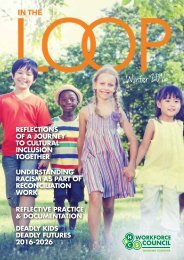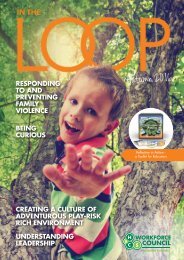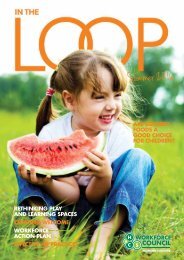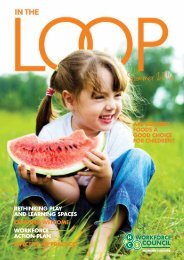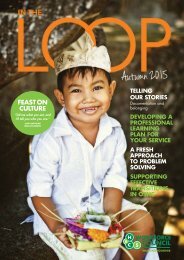The Loop Spring 2015 web.pdf
- No tags were found...
You also want an ePaper? Increase the reach of your titles
YUMPU automatically turns print PDFs into web optimized ePapers that Google loves.
ATTENDING AN EARLY CHILDHOOD EDUCATION AND CARE PROGRAM SUCH AS<br />
LONG DAY CARE OR FAMILY DAY CARE IS AN IMPORTANT AND EXCITING STAGE<br />
IN A CHILD’S DEVELOPMENT.<br />
Children have opportunities to interact with other children and<br />
educators and benefit from a stimulating learning environment.<br />
Some children embrace this change with an enthusiasm that<br />
can leave parents feeling confident and comfortable. Other<br />
children may feel afraid, upset or anxious. It may be the first<br />
time they have been in the care of adults who are not part of<br />
their family, or the environment could be noisy and crowded<br />
compared to being at home, making it all feel a bit too much.<br />
In early childhood, crying, tantrums, or clinginess are healthy<br />
reactions to separation and a little worry over leaving the<br />
primary care giver/s is normal, even when a child is older.<br />
Separation anxiety usually starts at about six to eight months<br />
of age and lasts until about two and a half to four years of<br />
age. From about six months old, most children begin to show<br />
distress when they are away from their parents or carers.<br />
Children at this age don’t yet have a separate sense of self,<br />
so they can feel a part of them is missing. While this can be<br />
worrying for parents and carers, it is normal for children to<br />
find the transition to childcare upsetting and it is important to<br />
remember the distress is often short-lived.<br />
EASING SEPARATION ANXIETY IN CHILDREN<br />
For parents and children starting childcare for the first time<br />
separation anxiety is common. For many children, childcare is<br />
their first experience of extended separation from their parents<br />
and for many parents the guilt they have about leaving their<br />
child can make the first few days of childcare an emotional<br />
time. Separation anxiety may also occur despite the child<br />
having previously coped well in childcare as they progress<br />
through their next developmental stage (e.g. a child in care<br />
from 2 months suddenly develops separation anxiety at 8<br />
months). A little preparation can go a long way towards<br />
decreasing the anxiety felt by both children and parents as<br />
they become accustomed to the new arrangement or next<br />
developmental stage:<br />
• Develop a “goodbye” ritual. Rituals are reassuring and can<br />
be as simple as a special wave through the window or a<br />
goodbye kiss.<br />
• Leave without fanfare. Encourage parents to tell their child<br />
they are leaving and that they will return, then go —don’t<br />
stall.<br />
• Manage your emotions. Separation is difficult on parents/<br />
carers as well as the child. Encourage families to put on a<br />
brave face when leaving their child (use a cheerful tone of<br />
voice and try not to allow the child to see you upset).<br />
Remember, some children adapt more quickly to childcare<br />
than others and the transition period that the child, family, and<br />
child care centre go through will depend on factors such as<br />
the child’s age, stage of development, previous experiences<br />
with other carers, and the child care environment.<br />
SYMPTOMS OF SEPARATION ANXIETY<br />
DISORDER<br />
Separation anxiety can vary in intensity and timing from one<br />
child to the next. However, some kids experience separation<br />
anxiety that doesn’t go away, even with a parent’s or carer’s<br />
best efforts. If this anxiety intensifies or is persistent enough<br />
to get in the way of childcare, school or other activities,<br />
the child may have separation anxiety disorder. Separation<br />
anxiety disorder is NOT a normal stage of development, but<br />
an emotional problem characterised by extreme distress when<br />
a child is away from the primary caregiver. However, since<br />
normal separation anxiety and separation anxiety disorder<br />
share many of the same symptoms, it can be confusing to try<br />
to figure out if a child just needs time and understanding—or<br />
requires professional support.<br />
<strong>The</strong> main differences between healthy separation<br />
anxiety and separation anxiety disorder is the<br />
intensity of the child’s fears, and whether these<br />
fears keep him or her from normal activities.<br />
Children with separation anxiety disorder may become<br />
agitated at just the thought of being away from mum or dad,<br />
and may complain of sickness to avoid playing with friends or<br />
attending school.<br />
As an educator or as a parent it can be difficult to know how<br />
to respond to a distressed child so if you are unsure it can be<br />
helpful to encourage the family to seek professional support<br />
and advice. Professionals will be able to provide practical<br />
strategies that will allow the child to manage their anxieties<br />
and develop confidence and independence.<br />
To find out more about separation anxiety, learn<br />
practical strategies and obtain resources to help<br />
your centre manage separation anxiety, attend the<br />
‘No More Tears’ workshop being hosted by the<br />
Workforce Council.<br />
• Schedule separations after naps or feedings. Babies are<br />
more susceptible to separation anxiety when they’re tired or<br />
hungry.<br />
WORKFORCE.ORG.AU 23



